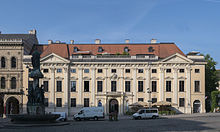Harrach Palace (Freyung)
The Palais Harrach is a Viennese city palace on the Freyung in the 1st district of Vienna Inner City .
history
In the place of today's Palais Harrach there were three smaller houses that were assembled by Jörg von Puchheim. In 1626 this building was bought by Reich Count Karl von Harrach . However, the Harrachs sold this building to the Auersperg family in 1658 .
As the old residential building burned down shortly before the second Turkish siege in 1683, it was sold again. The ruins were bought by the ambassador Count Ferdinand Bonaventura von Harrach , so that the building site fell back into the possession of the Harrach family. A new palace was built around 1690 on behalf of Count Ferdinand Bonaventura Harrach.
There was a departure from the usual building traditions and a reorientation towards the Baroque architecture of Italy. The plans come from the architect Christian Alexander Oedtl . The Roman architect Domenico Martinelli (1650-1718) was also involved in the planning. Stone cutting jobs were given to the Viennese master Veith Steinböck as well as Giovanni Battista Passerini and Sebastian Regondi from Kaisersteinbruch . The hard Kaiserstein was used for portals, columns and the staircase, among other things. In the issues relating to the building on the Freyung, one can read several times: “… an imperial wagon drove to the garden door in the Kaiser quarry by stone, the coachman and pioneer, each 3 meals, - more on 6 horse over one Night for hay, straw and stable money… ” .
Count Harrach described the stairs in his diary as "wider and not so gach (steep) compared to the structure in the Tuileries and ... more beautiful and gallant ... than the one in the Madrid palace of Duke Infantado " .
The palace housed, for example, the Harrach painting collection. It was badly damaged by a bombing raid in 1944, and was restored in 1948–1952 after the Second World War .
From 1994 to 2003 it served the Kunsthistorisches Museum as a location for ongoing special exhibitions, readings, lectures and concerts.
To the right of the palace was the garden, which was gradually reduced in size over time. Today a small green area reminds of this. A garden pavilion by Johann Lucas von Hildebrandt stood here until the bomb attack in 1944 , which formed a sharp border between Freyung and Herrengasse .
The Palais Harrach was owned by the company ÖRAG-Immobilien; Today it is owned by a foundation left by Karl Wlaschek in 2015 .
Individual evidence
- ^ Karl Wlaschek's real estate in the first district of Vienna , in: Falter (weekly newspaper) , No. 33/2015, August 12, 2015, p. 16
literature
- Günther Heinz: Catalog of the Count Harrach'schen Gemäldegalerie . Palais Harrach, Vienna 1960, OCLC 630481301 .
- Hellmut Lorenz : Domenico Martinelli and the Austrian baroque architecture, Das Stadtpalais Harrach, among other things publishing house of the Austrian Academy of Sciences, Vienna 1991, ISBN 3-7001-1859-7 .
- Wilhelm Georg Rizzi, Hellmut Lorenz, Luigi A. Ronzoni a. a .: Palais Harrach: history, revitalization and restoration of the house on the Freyung in Vienna . Rudolf Trauner University Press, Linz 1995, ISBN 3-85320-713-8 .
Web links
- Entry via Palais Harrach to Burgen-Austria
- Information about the Palais Harrach in Vienna
- Helmuth Furch 1995, Graefl. Harrachsche Archives and the Kaiser Quarry
Coordinates: 48 ° 12 ′ 41 ″ N , 16 ° 21 ′ 52 ″ E


